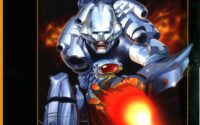Dragon Quest IV: Chapters of the Chosen Review
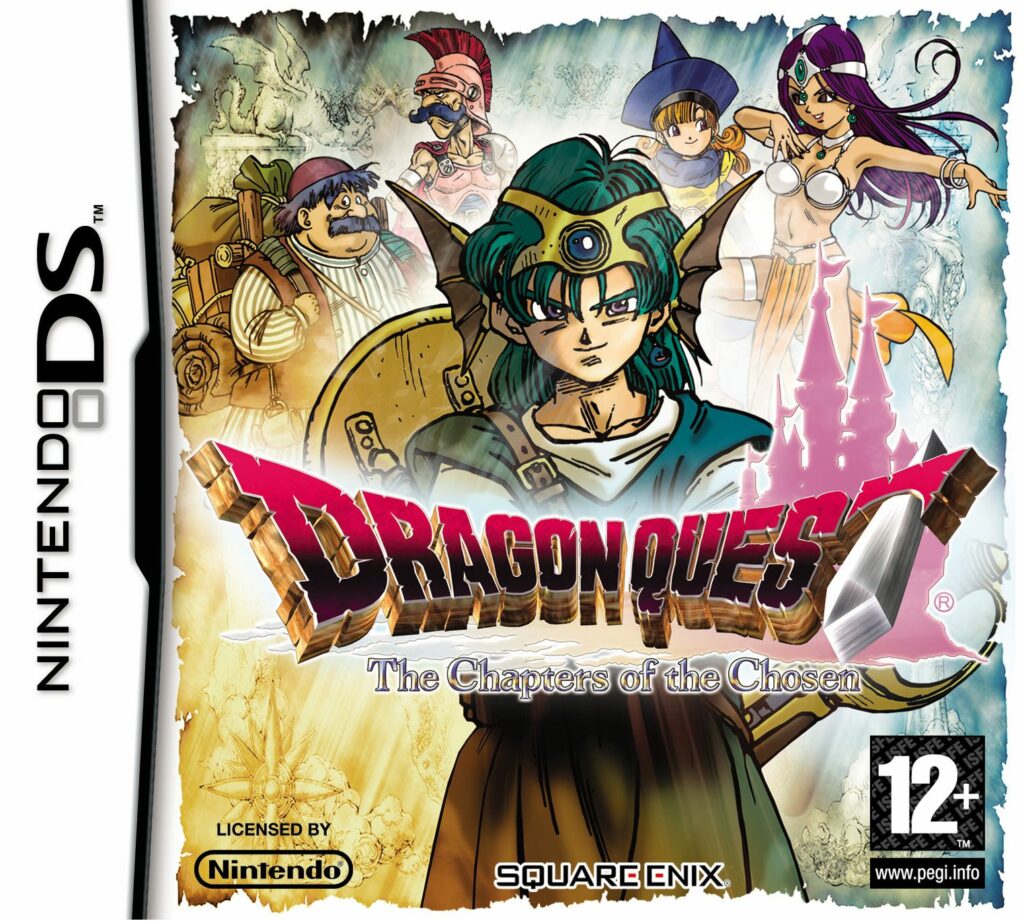
Fantasy roleplaying game with colorful graphics, great music and memorable story.
Story
An ancient prophecy foretells of mighty heroes who will save the world when evil rises from its sleep. People all over the world are now seeing monsters become rampant – children are being abducted and townspeople are being harassed. What’s worse is that an evil man is plotting to take over the world and use the monsters as his minions. Will the chosen ones emerge and save the world before it is too late?
The Game
Dragon Quest IV: Chapters of the Chosen for the Nintendo DS is a refreshing remake of the original NES game Dragon Quest IV released in 1990. The original game has been remade before, so it is only natural that Dragon Quest IV: Chapters of the Chosen is based on the PlayStation remake from 2001. This game is an epic fantasy roleplaying game filled with bravery, magic and wonders.
This is the first Dragon Quest remake released on the DS, taking the legendary franchise to a new, hand-held generation. So for people who hasn’t played these games before, this is a very good place to start. Being the fourth game in this beloved roleplaying game series, it has a stand alone story that can be enjoyed regardless of whether you have played the previous Dragon Quest games or not.
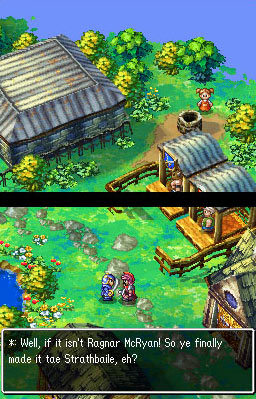
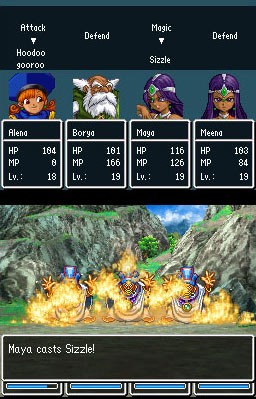
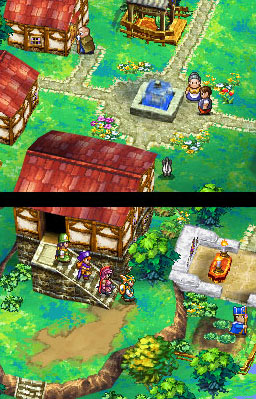
Controls
The controls are about as basic as they come. You walk around with your character using the directional pad and you’ll interact with objects and people by pressing the A button. Navigating menus is also simple and it all has a very comprehensive layout.
Perhaps the biggest problem about the controls is that you can’t fast forward text by holding down a button. During battles, you must keep pressing a button to proceed through the battle text and it gets very tiring in the long run. Even with the battle text speed option set to max and automated commands through the tactics feature you’ll still wish that you could just hold a button down to scroll through the text.
Since the game is rendered in 3D, you can rotate the camera using the L and R shoulder buttons. This feature is somewhat incoherent though. In towns you can rotate the camera freely. In some locations you can only rotate it to a certain degree. In some dungeons you can’t rotate it at all. It’s not a big deal but because of its haphazard state you’ll naturally just ignore using it. There are some rare occasions when you need to rotate the view in order to reveal a door or something like that, but it’s kept at a minimum and shouldn’t bother you.
Content
The game has a unique take on storytelling as you’ll get to follow numerous different protagonists through the adventure. They all have their motivations and personal goals but as the story progresses they’ll all become part of one truly epic adventure. So, the first fifteen hours (or so) of the game introduces you to five different protagonists and their background stories. These characters are; Luc; a young boy, Ragnar McRyan; a royal knight, princess Tsarevna Alena, Torneko Taloon; a weapons merchant and Maya; a dancer who seeks to avenge the death of her father. Once you’ve gone through their personal struggles you’ll see how they cross paths and the real adventure begins when they’re all aiming for the ultimate goal – saving the world from being destroyed.
This game is full of genre defining roleplaying game cliches. There’s the young boy who sets out to save the world, there are ladies in need of help, kidnapped children, kingdoms at war, world changing events, dragons, elves, dwarves, some lighthearted humor and even a bit of tragedy. It’s a sweet mix of everything and the portrayed world feels very coherent and believable – it’s very fleshed out and has lots of lore that you can learn just by talking to the people you meet. It’s pretty much the perfect backdrop for a storybook type adventure like this.
Regardless of whom you play as, you’ll talk to townspeople around the world to gather clues as to what’s going on and what you’re supposed to do next. There are hoards of monsters to kill and killing monsters will earn you gold and experience points. Experience points will make your characters stronger and capable of defeating even stronger monsters.
There are lots of towns, castles, dungeons, traps and secrets to explore and there are tons of weapons, items, armors and spells that you can use.
While exploring the game is played from an isometric top-down view. Battles are turn-based and they are viewed from a first person style perspective.
While the game features eight playable characters and seven allies that you can befriend, you can only have four people in your adventuring party at one time. This means that you can pick your favorite characters to form your lineup but it also means that you must drop some important competence as you can’t have it all. Some monsters are weak against certain spells and others are weak against physical attacks – you’ll probably need to cover both aspects if you want to have a well balanced, all-round party. You can swap party members at any time when you’re out in the open.
As you’re wandering around the world you’re thrown into random monster encounters all the time. The same goes for the many dungeons, caves and enemy lairs in the game. Of course, different monsters inhabit different areas, but the amount of random encounters is insanely high throughout the entire game. The time frame between monster encounters can be as small as just a two or three seconds. There are spells that you can learn that keeps monsters away though, but you will need to kill monsters in order to get enough experience points to strengthen the characters in your party. Even if you walk that extra mile and kill everything that comes in your way, you may still find that certain boss monsters are just too hard for your party. This means that you must kill even more monsters and upgrade your equipment when possible, which in turn often means collecting gold from defeated monsters. You certainly need at least some degree of drudging away at random monster encounters, so be prepared for that.
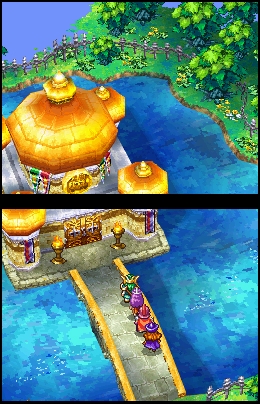
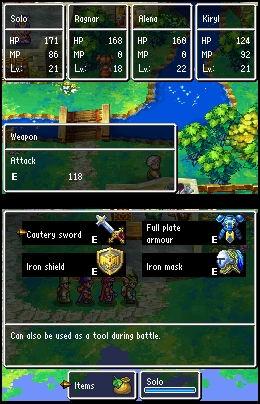
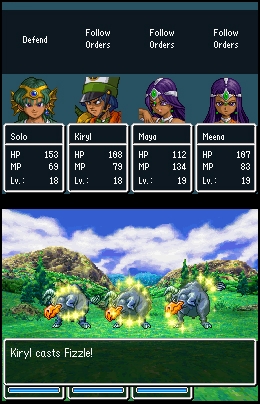
Either way you look at it, battles are a big part of the game. When you’re faced with baddies you’re prompted as to what you plan to do. You may try to flee from the fight (which often fails), issue tactical orders to your party members or fight. For each turn in a battle you issue orders to each of your party members. If you give them tactical orders, they’ll automatically follow those orders rather than have you give them orders manually every turn. The top screen shows what orders are currently active for each party member along with your character’s health status. The bottom screen shows the monsters you’re fighting and a comprehensive health bar for each of your characters. Once all orders are given, the game will have all combat participants carry out their orders in turns. The turn order is based on the participants agility statistics, so if you have agile characters they’ll act early in the turn sequence. Once every character and every monster has made their move, a new turn begins, repeating the process.
You aren’t given exact information about when your characters get to act in a battle, but after a few battles you’ll learn to estimate it, so you can, with some accuracy, plan ahead and adapt your combat strategy on a turn to turn basis.
Your party members are smart enough to automatically target the weakest creature in a group of enemies. They can even select their own targets if their original intended target is killed before they get to act, so the battles are pretty streamlined in that regard.
The battles have very little variation though. Random encounters never require any special thought, so if your party is of proper power level you can just button-mash your way through random encounters until you run out of healing spells. In that sense battles usually aren’t very intriguing.
Dragon Quest IV: Chapters of the Chosen is a long game. The main story consists of five chapters, and playing it through will take around 30 hours. Beating the game will allow you to play a final sixth chapter, which focuses on a storyline left unsolved in the main story. This extra chapter is surprisingly fleshed out as it features lots of new monsters, two new boss battles, some of the best weapons you can find, the toughest dungeon in the whole game and whole new dungeon designs. It easily adds five or so extra hours of gameplay to the already lengthy adventure. It should be noted though, that most of this play time will consist of mindless experience point hunting because the extra boss battles require a very strong and tactical party.
The main difficulty in the game is knowing what to do next. Most of the time you’re given clear hints on where you should go to move the story forward. But later in the game, the whole world becomes your area of operations and the clues you get are sometimes insufficient, leaving you with little or no indication of what to do next. To make things worse, the game has a few optional side quests, which all seamlessly flow in and out of each other. It’s also worth pointing out that the story does have some illogical twists and turns, causing further confusion. There is no adventure log feature in the game, so you must keep track of clues and hints yourself. Keeping it in your head is not a problem unless you take a break from the game for a longer period of time. Some clues can be repeated by talking to the right NPC, but dialogue that progresses the story will only be spoken once.
Dragon Quest IV: Chapters of the Chosen features three game save slots. You can save your progress every time you talk to a priest in a church (cleverly called “confession”). You can also suspend your game at anytime if you abruptly need to take a break. This allows you to pick up exactly where you left, but you can only continue from such a suspension point once, making it a temporary save.
Churches are evenly spaced and typically found in every town, castle and village. It’s also worth noting that even if your party gets wiped out, you will be resurrected at your last visited church. You will retain all your progress, but resurrecting fallen party members will cost some of your hard earned gold unless you’ve learned a spells that can resurrect people. The game keeps track of how many battles you’ve been in, how many times you have been defeated and how many times you’ve fled. Apparently this is only for reference and does not affect the game.
Dragon Quest IV: Chapters of the Chosen has dynamic day and night cycles. Depending on time of day in the game townspeople will act accordingly. Shops will close down at night and the taverns will see commerce. Some story elements are only available on either day or night, so you may need to look at things twice. It certainly adds to the feeling that the game world is alive – it’s good stuff.
The game has around 200 different monsters and you get to explore many interesting locations such as underground tunnels, castle dungeons, temples, mines, a sky castle and even explore water filled caverns with a raft. The variety is very nice, so the game keeps fresh even though the basic game flow and mechanics are the same all the time. The monsters you’re fighting include everything from slimes, hairy beasts, ghosts, evil wizards, devils, skeletons, dragons, ogres and giant octopuses. You’ll encounter the same monster types a few times with different color variations and there is a bestiary in the game that keeps track of all the monsters you encounter.
As mentioned above, there are lots of secrets and hidden treasures in the game. Exploring every area thoroughly will often be enough to find a hidden treasure chest or two. Weapons that you find are often better than what can be bought at weapons merchants, so it’s totally worth having an extra look if you overlooked a part of a dungeon.
Other than magical accessories, healing items and various stat-boosting magical edibles, there are also special medals that you can collect. These medals are useless on their own, but you can exchange them for rewards at a special trader. The medals are well hidden and all around the world, and while the rewards are good, they are mostly duplicates of powerful items that can be found in the game otherwise. Since you can only equip one accessory per character, having two of the same will often be redundant.
When you are fighting monsters out in the wild all your party members will receive the same amount of experience points. This means that characters that aren’t in your active party will still be able to make progress and grow stronger. They will, however, miss out on the experience that you earn in dungeons, so neglected characters will fall behind albeit slowly.
Leveling up your characters can certainly be tedious and time consuming but there are ways to help it. Later in the game you’ll encounter special monsters called Metal Slimes. They’re hard to catch (they often flee from the battle) and hard to kill, but if you manage to land a critical hit on one, you’ll kill it. They come in various sizes and experience reward from them is ridiculously high. You’ll eventually track down locations where they often show up and there you could hang around and hunt for them. This is, as far as we know, the fastest way to level up the characters – once you find their locations and start killing them you’ll potentially save hours worth monster hunting.
Dragon Quest IV: Chapters of the Chosen is very strong on charm. The story has lots of memorable parts, such as having you run a weapons store serving NPC customers, flying a gas balloon, having your party accused of theft, helping a young boy establishing a new town, sneaking into a castle at night and fooling enemy monsters with clever disguises. As such the story is well written as it manages to weave all these threads into one – and it will probably stick in the players hearts for the rest of their lives.
Throughout the adventure you’ll revisit many locations that you’ve previously been to. Sometimes you’ll be able to access areas that you previously could not, so early in the adventure you’ll see lots of mysterious locked doors that you’ll eventually return to later. If there is a sentimental bone in you, you’ll find that revisiting locations will strike just that bone. NPC characters will either have fond memories of members in your party, or they’ll talk about events that you previously were involved in. It’s certainly a nice touch and it’s amazing how much unique dialogue there is.
Even though the adventure is relatively long it’s strange how all the powerful weapons are found in the last few hours of the game. In fact, the last few dungeons are showering you with high experience point rewards and powerful magic items. It feels kind of unbalanced but it’s also gratifying to be able to destroy hoards of strong monsters and see your characters level up like never before. If you’re going to beat the extra chapter as well, you will need all the power you can get because it’s much tougher than anything else in the game.
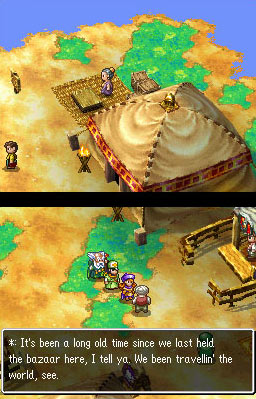
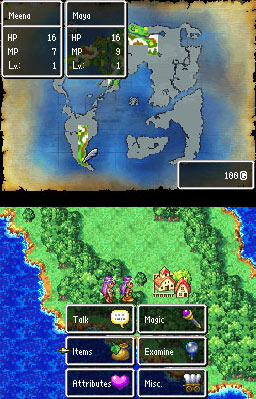
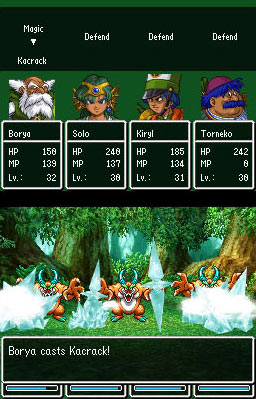
Graphics
The graphics are very lovable as it effectively mixes nice colorful 2D sprites with a 3D environment. The fantasy theme is present at all times and the environments are quite well detailed. It easily sparks the imagination and there are many different locations to explore.
The highlight is the monster animations during battles. The monster sprites are huge and the attack animations are smooth and outright brilliant. All other animations such as spell effects and your parties attacks are not as exciting though.
Sound
The soundtrack of Dragon Quest IV: Chapters of the Chosen is instantly recognizable as great fantasy roleplaying music. It has an orchestral touch, and most of the melodies are very catchy and even sticky. Some of the music has a jolly, cartoonish style, and some has a more serious, epic tone. You will, however, grow tired of the same songs after playing for a while, and sadly there isn’t much variation in the music. Certain locations have special music tied to it which is refreshing, but mostly you’ll hear the same few songs over and over.
Depending on time of day in the game, the music changes: during nighttime, you’ll hear a calm, almost soothing version of the daytime music. It’s a simple effect, but it certainly manifests a cozy atmosphere in a natural way.
The sound effects come mostly from menus and dialogue boxes and it consists of simple ding-a-lings. Spells and attacks have their own sounds too, of course, but it’s nothing special.
Summary
Dragon Quest IV: Chapters of the Chosen is one epic roleplaying game. It has good graphics, good music and some truly memorable episodes. All in all, it’s a great and inspiring roleplaying adventure. Its weakness is that it requires loads of repetitive battling and it can be quite mysterious about where you should go next. We’re not expecting to be led by the hand all the time, but when you aren’t given any clues as to where you’re supposed to go, it just feels like you’re being cheated. If you push through the whole journey though, it is satisfying in the end and you will be able to look back at it with a warm fuzzy feeling.
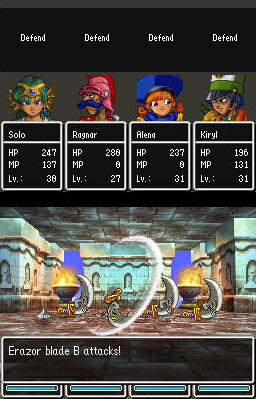
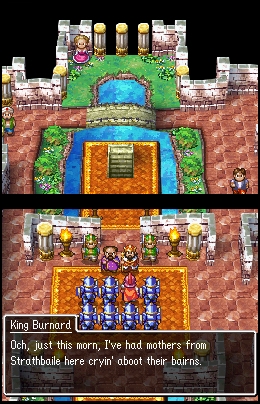
Developed By: ArtePiazza
Published By: Square Enix, Inc.
Version Reviewed: Nintendo DS
Genre: Roleplaying
Players: 1
Also Available On: NES, PlayStation, Mobile
Released: 2008-09-12
About The Author
Mattias
Played my first video game in the 80's on the Commodore 64, and have been hooked since then. Loved the 16-bit era, the glossy magazines, and the colorful arcade games from that time.



